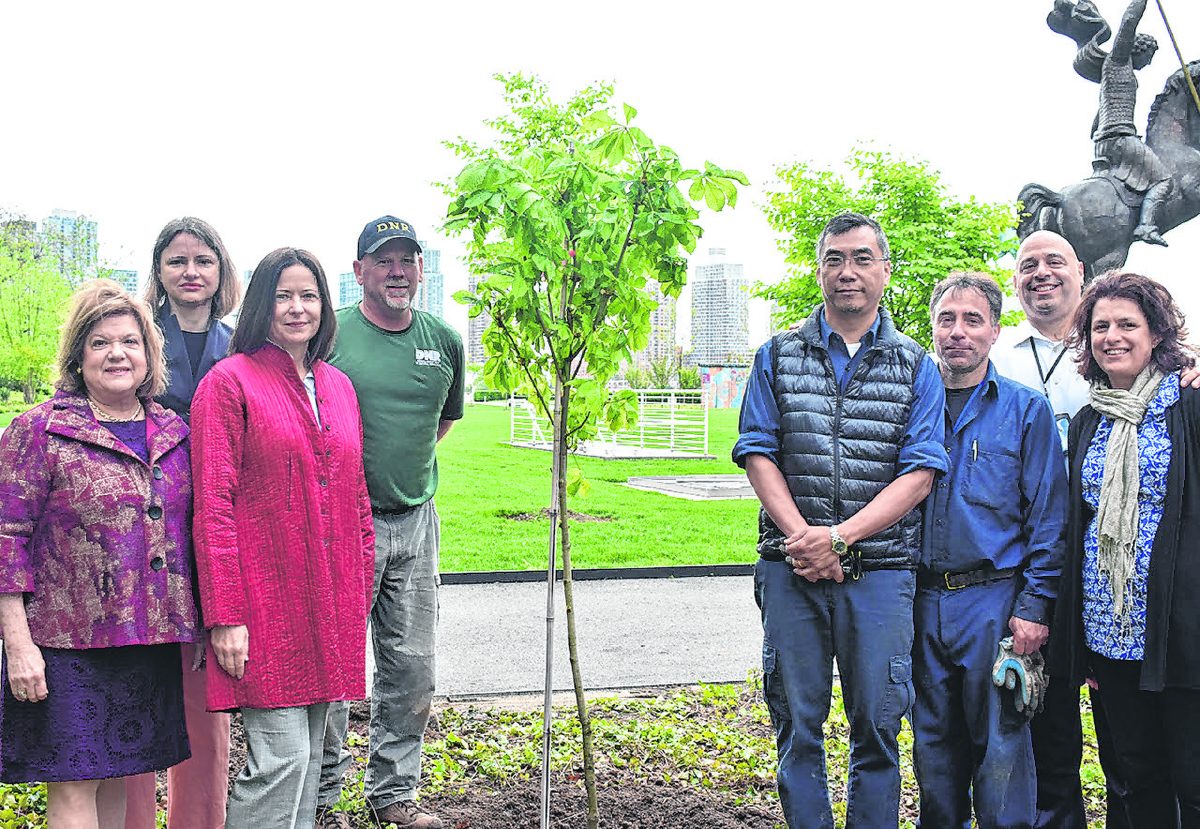
VALLONIA
The symbol of hope Anne Frank shared in her diary was a large horse chestnut tree that stood outside her window while she was in hiding.
The teenager who would later die in a German concentration camp in 1945 often referenced the tree, which ended up collapsing Aug. 23, 2010, in her diary that would later become “The Diary of a Young Girl,” also known as “The Diary of Anne Frank.”
[sc:text-divider text-divider-title=”Story continues below gallery” ]
Click here to purchase photos from this galleryOn Wednesday, many around the world gathered to celebrate what would have been Frank’s 90th birthday.
During a ceremony at the United Nations headquarters in New York City, officials with the Anne Frank Foundation, dignitaries and others unveiled and dedicated a plaque planted in front of a tree grown from a sapling of the same horse chestnut Frank wrote about.
Jackson County had a significant impact on the ceremony.
The sapling unveiled during the program was grown at the Vallonia State Nursery.
Bob Hawkins, who manages the nursery, made the trip to New York City and planted the tree May 9 at the United Nations Peace Garden.
The nursery received three saplings in 2013, the Vallonia man said, and each were planted at the nursery. One was planted at the U.S. Capitol in 2014.
The third, which has reached more than 8 feet, remains at the nursery awaiting its site.
U.N. Secretary-General Antonio Guterres said in a statement read at the ceremony the sapling “is a living symbol of both the legacy of Anne Frank” and the values of the United Nations, which was established in the aftermath of the war and the Holocaust.
“The tree into which the sapling will grow will stand as a beacon of hope, a living reminder of the importance of continuing the work for a just and peaceful world in which we celebrate diversity and where men and men, young and old can thrive without fear,” Guterres said.
Sharon Douglas, chief executive officer of the Anne Frank Center for Mutual Respect, which donated the sapling, said, “The tree lived in the free air and represented to Anne a living symbol of hope and freedom.”
The Frank family’s hiding place for two years in the secret annex behind a canal-side house was discovered, and Anne was taken to the Bergen-Belsen Nazi concentration camp, where she died in February 1945 at 15.
Her father, Otto, the only member of the family to survive the war, later published her diaries, which have been read around the world and are considered one of the most important books of the 20th century.
The Anne Frank Center for Mutual Respect in New York received 11 of the saplings to donate to worthy educational organizations across the United States. The nursery received three that were given to the Children’s Museum of Indianapolis. That organization did not have the means to care for the saplings, so representatives from the museum contacted Hawkins.
After a three-year safeguard quarantine, the saplings were cleared for planting in January 2013.
Hawkins said all other saplings from the original parent tree died except for the three cared for by the Vallonia State Nursery.
“They (foundation) were very adamant about me keeping them alive and keeping them well,” he said.
Hawkins said that put a little pressure on him to make sure the sapling remained healthy.
He said staff didn’t do anything special, but the ground there is very fertile. The environment is perfect for trees to grow because it is sandy, rich in nutrients and has plenty of moisture, Hawkins said.
“Good care and good nutrients and good upkeep helped it,” he said.
But having such a significant role in a project so tied to history made for interesting work.
“I think this is a neat opportunity for me to be a part of all this and experience some of the things I’ve gotten to experience in the planting of a couple of these trees in historic places,” he said. “I think it will be really awesome to visit these sites years from now and know I planted this tree and was part of the endeavor.”
The nursery is not going to stop with just the three saplings, as plans to add more through grafting already are underway.
Phil O’Connor, a tree improvement specialist at the nursery, has been grafting from the horse chestnut trees for a couple years. There are about two dozen grafted trees in the greenhouse at the 220-acre nursery.
The grafting process includes finding a root and cutting a diagonal edge to it. The same is done on a dormant limb from the horse chestnut tree.
The two edges are lined together and wound with a band. Tops are sprayed with Treekote to assist with growth.
They are then potted and cared for the same as other plants before being transferred into the ground. A few are expected to be planted later this year, O’Connor said.
The result is the same genetic compound of the original tree.
“I honestly didn’t think as much about the historical significance, but it was interesting for me because I’d never grafted that species before,” O’Connor said. “It is interesting, and we can tell people what we were able to do.”
Hawkins said being able to help continue the legacy through grafting is a rewarding experience because the genetics are the same as the tree Frank wrote about.
“The foundation is excited about this,” he said.
Hawkins is excited, too, both for the new grafted trees growing in the greenhouse and the opportunity to help keep the history of a teenage girl alive.
“It’s been interesting to be in touch with these people and be a part of that history,” he said. “’The Diary of Anne Frank,’ pretty much everyone has read it or parts of it in school.”
